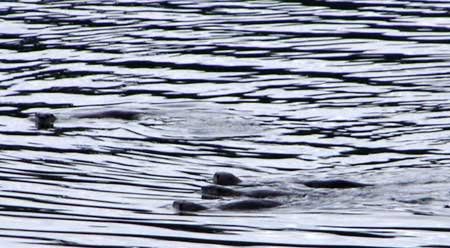
June 5, 2007

Otters, of course, are responsible for a few misidentifications of Lake Monsters in bodies of water worldwide.
In my The Field Guide to Lake Monsters, Sea Serpents, and Other Mystery Denizens of the Deep (co-authored by Patrick Huyghe), the fact that people do make mistakes when viewing mundane mammals on lakes and lochs is acknowledged. Otters, nevertheless, have never been seen as the root of all Lake Monsters accounts, as seemed to be expressed on CNN’s “Paula Zahn Now” last week by the guest skeptic.
Otters are hardly in vogue any longer. Even Bernard Heuvelmans’ theory of the “super-otters,” as a type of Sea Serpent, has fallen from favor.
One of the “otter nonsense” points of the CNN interview was for Joe Nickell to, more or less, say that all Lake Monster reports could be explained as being otters.
Indeed, Nickell does use this simplistic broad brush to explain several Lake Monster reports.
In Nickell’s and Benjamin Radford’s Lake Monster Mysteries: Investigating the World’s Most Elusive Creatures, “otter” is the underlying explanation that is often used.
Various remarks from that book confirm Nickell’s theme, in which he and Ben Radford use others’ conclusions to support this all-encompassing “otter” theory:
Loch Ness, Scotland
[Quoting Ronald Binns]…With its long neck and plesiosaurlike profile, the otter is quite likely to be perceived as a monster, especially when an adult with two or more young are swimming in a line, creating the semblance of a multihumped creature, p. 13.
[Regarding the August 1933 sighting Spicer sighting, referencing a local newspaper]…the creature was almost certainly a large otter, possibly carrying one of its young, p. 13.
[Dick Raynor’s film of 1967, pointing again to Binns]…that, in my opinion, shows an otter or otters, p. 19.
Lake Crescent, Newfoundland
[Obviously, Radford writing]…Otters are very common in and around the lake, and as Joe Nickell has pointed out in earlier chapters, otters can be (and have been mistaken) for lake monsters, p. 96.
Lake Okanagan, British Columbia
[Speaking of Ogopogo, it is noted]…Lake Okanagan is in the home range of…otters, p. 113. Ogopogo and the supposedly responsible otters surface again on pages 117-120 and 168.
On pages 37-38, Nickell mentions otters as the explanation for cryptids in Lake Champlain, Vermont/New York/Quebec; a lake in Clinton County, New York; Loch Arkaig and Loch Ness, Scotland; Lake Utopia, New Brunswick; and Silver Lake, New York (the latter also on pp. 86-87).
On page 73, the Radford-Nickell book links otters to sightings of Memphre in Lake Memphremagog, Quebec and Vermont.
On pages 141-142, Nickell theorizes that at least one sighting of “Beaverton Bessie” or “Kempenfelt Kelly,” seen near Beaverton, Ontario, “could reasonably be explained by otters swimming in a line, diving, and resurfacing,” (page 141).
Reasonably? This is otterly overwhelming. Otterly ridiculous.
If so many otters around the world are “swimming in a line” to fool eyewitnesses into thinking they are the loops of Sea Serpents or Lake Monsters, where are all of the photographs of such visual demonstrations in Nickell’s book? The volume has photos throughout, but not one of these supposedly abundant otters swimming in a line. Oh yes, there is one illustration of “Northern river otters, swimming in a line” in the book. It is a line drawing by Joe Nickell, on page 118.
I was able to find a photograph (see at top) of multiple otters swimming in a lake. Their heads appear rather large and blunt, not “plesiosaurlike” (to use a Nickell descriptor) or even “long-necked.” Also, they happen to be swimming…side by side.
I invite submissions of photographs of otters “swimming in a line,” which look like the humps of a Lake Monster.
About Loren Coleman
Loren Coleman is one of the world’s leading cryptozoologists, some say “the” leading living cryptozoologist. Certainly, he is acknowledged as the current living American researcher and writer who has most popularized cryptozoology in the late 20th and early 21st centuries.
Starting his fieldwork and investigations in 1960, after traveling and trekking extensively in pursuit of cryptozoological mysteries, Coleman began writing to share his experiences in 1969. An honorary member of Ivan T. Sanderson’s Society for the Investigation of the Unexplained in the 1970s, Coleman has been bestowed with similar honorary memberships of the North Idaho College Cryptozoology Club in 1983, and in subsequent years, that of the British Columbia Scientific Cryptozoology Club, CryptoSafari International, and other international organizations. He was also a Life Member and Benefactor of the International Society of Cryptozoology (now-defunct).
Loren Coleman’s daily blog, as a member of the Cryptomundo Team, served as an ongoing avenue of communication for the ever-growing body of cryptozoo news from 2005 through 2013. He returned as an infrequent contributor beginning Halloween week of 2015.
Coleman is the founder in 2003, and current director of the International Cryptozoology Museum in Portland, Maine.
Filed under Books, Breaking News, Cryptomundo Exclusive, Cryptotourism, CryptoZoo News, Cryptozoologists, Cryptozoology, Eyewitness Accounts, Forensic Science, Lake Monsters, Loch Ness Monster, Ogopogo, Photos, Reviews, Sea Serpents, Videos